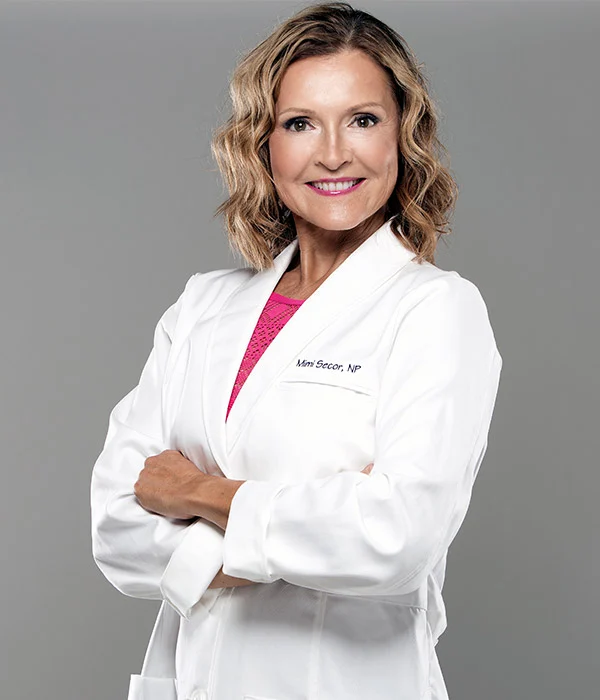
On-Demand
Package 2
$687
Earn 39 CME Credit Hours (Rx=12.25) on your time with this engaging new package of 2022 courses! Learn about spotting a heart attack, new dermatology drugs, diabetes, pediatric ortho, contraception use across the lifespan, and more. Features 8 tracks, 8 presenters, and our new enhanced viewing platform.
Course Overview For Package 2
- Cardiology &
Emergency Medicine - Dermatology
- Diabetes
- Emergency Room
- Mental Health
- Orthopedics
- Pain Management
- Women’s Health

Classes by Zach Hartsell, DHA, PA-C
Respiratory Cases (Rx=0.25)
This presentation will provide an overview of the distinctive types of acute respiratory failure and an overview of mechanism and pathophysiology. Emphasis will be placed on the initial evaluation, including oxygen supplementation techniques and indications/contraindications for the use of NIPPV. Finally, this presentation will provide an overview of acute respiratory distress syndrome, focusing on diagnostic criteria and a review of evidence-based treatment guidelines.
Managing Airline Emergencies
As the world gets back to travel, medical emergencies on airlines will once again be on the rise. Before the pandemic, it was estimated that approximately 1 in 10,000 passengers have a medical event onboard aircraft each year. Seventy-five percent (75%) of these are minor medical events that can be treated with simple first aid. While serious medical events are rare, clinicians need to know how to respond to such emergencies. Using a case-based format, this presentation will review the common medical conditions encountered in flight, resources available to providers, and the legalities surrounding responding to out-of-hospital emergencies. Infectious disease considerations will be reviewed and discussed. In addition to general concepts, this presentation will focus on problem-specific treatments.
Acute Kidney Injury Cases
With kidney disease on the rise, a patient presenting to the emergency department with acute kidney injury will continue to increase. This case-based presentation will allow participants to confidently assess and classify patients with suspected kidney injury, identify the most common precipitants of acute kidney injury, differentiate between acute and chronic disease, and understand the first-line therapy for the treatment of acute kidney injury. We will also review indications for urgent dialysis.
Chest Pain Evaluation: Mimic, Red Herring, or the Real Deal? (Rx=0.25)
Chest pain is one of the most common chief complaints to the emergency departments, with definitive diagnosis elusive in most cases. However, who gets to be sent home? Who requires admission? This presentation addresses those specific questions with a review of the challenges in delineating cardiac vs. non-cardiac chest pain. A heavy emphasis will be placed on risk stratification methodologies for patients with suspected cardiac chest pain and an evidence-based approach to the initial evaluation. Finally, this presentation will review optimal testing strategies for both cardiac and non-cardiac etiologies of chest pain, including current controversies and guidelines.
Syncope Evaluation and Management
This presentation will review the common cause of syncope and pathophysiologic mechanisms that commonly lead to syncope. With a focus on initial evaluation and management, this presentation will review the guidelines and risk stratification tools available to aid in diagnosis. Finally, this presentation will provide an evidence-based approach to disposition and follow-up.

Classes by Cynthia Griffith, MPAS, PA-C
Psoriasis: Presentation, Exacerbators and Treatment (Rx=0.25)
Psoriasis is a common chronic inflammatory disease of the skin that is increasingly being recognized as a systemic inflammatory disorder. According to current studies, more than 8 million Americans have psoriasis. A rapidly expanding body of literature supports additional associations between psoriasis and cardiometabolic diseases, gastrointestinal diseases, kidney disease, malignancy, infection, and mood disorders. Given the variety of manifestations of this condition, education of healthcare providers is essential to ensuring comprehensive medical care for patients with psoriasis. This session will provide an update on the diagnosis and treatment of psoriasis.
Benign Skin Lesions Uncoded
Can you recognize benign skin lesions from cancerous ones? So much of skin lesion identification and diagnosis is pattern recognition. This is a photo-filled talk that will expand your clinical diagnostic skills and ability to visually diagnose seborrheic keratoses, dermatofibromas, cherry angiomas, venous lakes so that you can distinguish them from skin cancer.
Dermatologic Drugs and Drug Reactions (Rx=0.75)
What is the difference between a cream and a lotion? In the first half of this two-part talk, we will review common dermatologic drugs, vehicles and their uses. In the second half of the talk, we will discuss drug reactions ranging from the serious Toxic Epidermal Necrosis and Steven Johnson Syndrome to the benign. This lecture will demystify common medication culprits that cause drug reactions as well as initial labs to elucidate severe from self-limited drug rashes.
Skin Cancer Explained (Rx=0.25)
The majority of skin lesions are benign, but when do you need to worry or biopsy? Skin cancer is by far the most common type of cancer. Basal cell carcinoma, squamous cell carcinoma, and melanoma could be cancers that you either diagnose or miss on a daily basis. This lecture will equip you to look at a spot and recognize concerning clinical features, be equipped to take the next step and biopsy the site, and have the knowledge to direct treatment of the cancer with medical or surgical treatments.
Common Culprits in Pediatric and Adult Dermatology (Rx=0.50)
Every clinician that sees children and adults could benefit from this refresher on everything that is common in skin disease. In this case-based discussion, we will cover diagnosis and treatment tips for acne, warts, fungal infections, atopic dermatitis, and more. This will be a fast-paced and high-yield discussion packed with clinical pearls that you can use every day in your clinical practice.

Classes by Debbie Hinnen, APN, BC-ADM, CDCES, FAAN, FADCES
DIY Diabetes (Part 1)
Do not let Diabetes overwhelm you. If you understand the metabolic defects and how medications address those problems, you are well on the way to Doing It Yourself. Do you ever need to refer to a diabetes specialist? Of course. For comprehensive diabetes self-management education and medical nutrition therapy for EVERY patient; at diagnosis, annually and when major medication and life changes occur. Can you manage their medication therapy? Yes! This workshop will help you be pro-active with diagnosis, medication management, therapy intensification, 5-minute nutrition counseling, dealing with barriers your patients with T2DM struggle with, and when to refer to the diabetes specialist.
DIY Diabetes (Part 2) (Rx=1.50)
Do not let Diabetes overwhelm you. If you understand the metabolic defects and how medications address those problems, you are well on the way to Doing It Yourself. Do you ever need to refer to a diabetes specialist? Of course. For comprehensive diabetes self-management education and medical nutrition therapy for EVERY patient; at diagnosis, annually and when major medication and life changes occur. Can you manage their medication therapy? Yes! This workshop will help you be pro-active with diagnosis, medication management, therapy intensification, 5-minute nutrition counseling, dealing with barriers your patients with T2DM struggle with, and when to refer to the diabetes specialist.

Classes by Melissa Kalensky, DNP, FNP-BC, CNE
Making Your “What Can Kill” List & Identifying That “Needle in a Haystack”
We often see the same complaints over and over again yet, less than 10% of those cases are triaged as requiring immediate or emergent intervention upon arrival to the emergency room. This presentation will look at some of the most common clinical complaints – abdominal pain, chest pain, fever, cough, and headache – focusing on quickly identifying “red flags” that require expedient workup. We will focus on elements of the history/physical exam that can help you consider how to triage these patients and work through some cases involving common complaints that end up as clinical zebras.
Abdominal & Pelvic Pain- From Cholecystitis to Cervicitis, to Calculi, Oh My! (Rx=0.25)
This presentation will focus on the nearly 1 in 10 patients presenting to the emergency department who have a complaint of abdominal and/or pelvic pain for less than seven days. We will discuss elements of the history and physical exam that are essential in building a broad differential, including atypical presentations. We will review considerations in ordering the most appropriate laboratory and imaging studies to narrow this differential and rule out life-threatening pathology. Particular considerations for changes in pathology with age, acute pain in pregnancy, and pain accompanied by vaginal bleeding will be highlighted as well.

Classes by Josh Hamilton, DNP, RN-BC, FNP-C, PMHNP-BC, CTMH, CNE, FAANP
Benzodiazepines: Safe Prescribing in the Era of Prescription Drug Abuse (Rx=1.0)
This presentation will focus on the class of anxiolytics known as benzodiazepines. Over the years, prescribers have had a love/hate relationship with these controlled substances. Upon completion of this presentation, participants will learn the benefits and risks related to the safe prescribing of benzodiazepines for individuals with various symptom presentations. The presentation will address the risks and cautions related to the prescribing of benzodiazepines with various medications, including opioids and stimulants, and in different healthcare settings. Participants will also receive tips from identifying the warning signs of benzodiazepine abuse and techniques to safely taper and discontinue these medications to minimize withdrawal discomfort.
Keeping it Simple: The Power of Brief Therapeutic Interventions
Compelling evidence suggests that both medications and therapeutic interventions are effective in the treatment of psychiatric disorders. The current “state of the science” involves multiple modalities to produce better outcomes than those observed using either psychopharmacology or therapy alone. Clinicians in all settings need to understand how various therapeutic interventions can profoundly influence clients’ ability to cope and change. Using the unifying framework developed by Hubble, Duncan, and Miller, we examine the four common elements that account for much of the improvement seen in clients, regardless of the approach taken. These constructs are applied to various simple, brief approaches that are easily enacted – and easily adapted – to any patient encounter.

CME Courses by Sarah Bolander, DMSC, PA-C, DFAAPA
Gain the Upper Hand for Evaluating Conditions from the Wrist to the Digits
Hand conditions can make activities of daily living particularly challenging. A thorough history and physical exam will narrow down your differential and guide the need for imaging. Specialized exam techniques will be demonstrated, and initial management options reviewed. Many of these conditions respond well to conservative treatment when recognized early.
I Spy: Basics of Skeletal Radiology and Fracture Identification
Can you spy the fracture line, or do you wait on the radiology report? Interpreting skeletal radiology may be daunting, but this skill allows providers to correlate imaging findings with a clinical exam to identify even subtle fractures. This interactive session will offer the essential tools needed to identify and describe fracture findings from plain radiographs appropriately.
Name-That-Fracture: Eponyms and Other Named Injuries
What is in a name? Eponymous fractures allow for rapid, succinct identification of complex injuries. Unfortunately, these named injuries are often mistermed, which can create confusion and misdirect management. Commonly named injuries of the upper and lower extremities will be clarified, and the language of orthopaedics will be further discussed.
Kids Can Run, But They Can’t Hide a Limp: Atraumatic Lower Extremity Conditions
A limping child can be a challenging presentation and is typically a worrisome feature in the absence of trauma. This session will outline an approach to pediatric lower extremity pain and discuss common causes for an atraumatic limp. Critical physical exam findings will be reviewed to guide the diagnostic assessment, and we will narrow the differential diagnosis to determine the urgency of management.
This Is… Ortho Jeopardy!
Play along as we review orthopedic topics from the day and introduce a few more. This interactive opportunity will allow you to put your knowledge to the test. Categories will include clinical presentation, mechanism of injury, specialized physical exam techniques, imaging, and management of common musculoskeletal complaints.

Classes by Brett Snodgrass, FNP-C, CPE, ACHPN, FAANP
Pain Treatment in the Opioid Epidemic: Opioids, Non-opioids, and Complementary Therapies (Part 1)
The opioid epidemic has raised many questions for the health care provider. It can be frustrating and difficult to care for patients in pain. What do you do with pain patients? How can you use opioids, and when? What other options are available? This session will look at the true opioid epidemic while putting things in perspective. We will focus on how to provide appropriate treatment for a patient in pain using opioids, non-opioids, and complementary therapies.
Pain Treatment in the Opioid Epidemic: Opioids, Non-opioids, and Complementary Therapies (Part 2) (Rx=1.5)
The opioid epidemic has raised many questions for the health care provider. It can be frustrating and difficult to care for patients in pain. What do you do with pain patients? How can you use opioids, and when? What other options are available? This session will look at the true opioid epidemic while putting things in perspective. We will focus on how to provide appropriate treatment for a patient in pain using opioids, non-opioids, and complementary therapies.

Classes by Mimi Secor, DNP, FNP-BC, FAANP, FAAN
Women’s Health Guidelines Update (Rx=0.25)
During this session, the epidemiology of selected conditions (breast cancer, STIs, cervical cancer, contraception, osteoporosis) will be discussed. New guidelines will be described focusing on the changes and rationale for these changes. Controversies among various guidelines will be presented and the clinical implications of these differences will be explored.
Contraceptive Update: What’s New? (Rx=1.0)
During this session, trends and contraceptive challenges facing clinicians and patients will be discussed. The new CDC medical eligibility criteria for prescribing various contraceptive methods and medical conditions will be explained. New contraceptive research regarding efficacy, risks, benefits as this pertains to prescribing will also be presented.
STI Update: Focus on the Female (Rx=0.25)
During this session the epidemiology of STIs will be discussed including recent trends and statistics. Explain diagnostic work-up for selected STIs including changes in HIV testing. Management will focus on recent changes including new gonorrhea treatment. This session will focus on the female and certain selected conditions including Herpes, CT/GC, PID, Cervicitis, HIV and Sexual Assault.
PCOS: Common, Complex and Serious (Rx=0.25)
During this session the epidemiology, complex pathophysiology, and serious associated risks and complications will be discussed. Symptoms, signs and diagnostic workup will be described. Discuss “best practice” management approaches including pharmacologic treatments and lifestyle approaches.
Menopause Alert: Hot Flashes, Vaginal Atrophy, Libido and More (Rx=0.75)
Describe epidemiology/physiology of menopause, Metabolic changes/Risks, Vasomotor Symptoms (VMS), Vulvovaginal Atrophy (VVA) and Low Libido (HSDDu003cemu003e). Discuss the diagnosis of VMS and Vulvovaginal Atrophy. Explain pharm/non pharm options/alternatives for treatment of VMS, VVA, and Low Libido/HSDD (u003c/emu003ehypoactive sexual desire disorder).